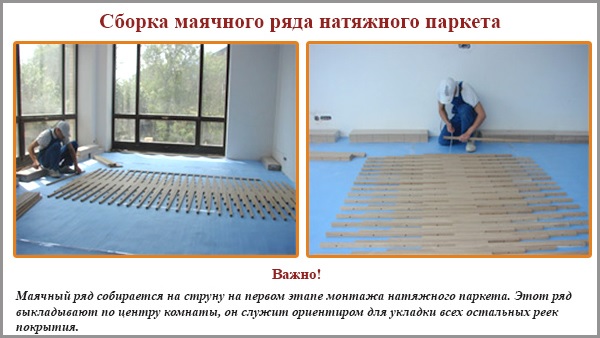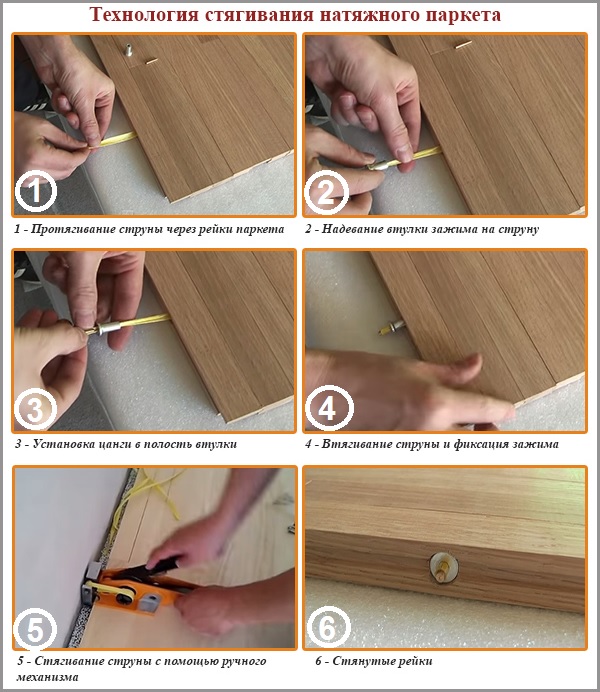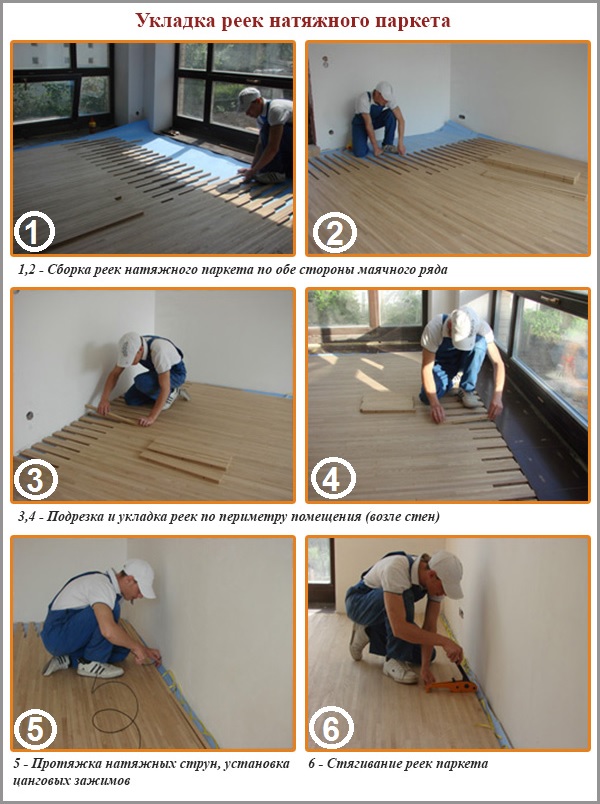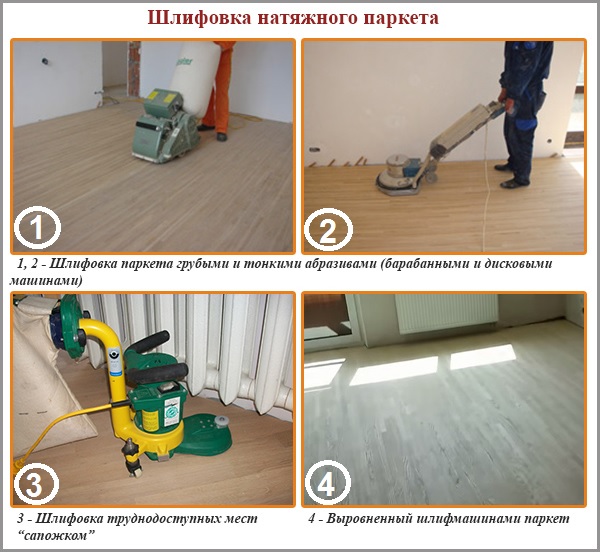Tension parquet: “tension” technology, its advantages and disadvantages
Stretched flooring is a new word in modern construction technologies. And if almost everyone is already familiar with the stretch ceiling, then parquet with the prefix “stretch” raises a lot of questions. What kind of flooring is this? How is it "pulled"? What are the advantages and disadvantages of technology? Let's try to figure it out.
Content
What parquet is called stretched?
Stretched parquet is wooden planks made of solid hardwood, which are laid by the tension method. During laying, the planks are interconnected into a lock, and then additionally pulled together with high-strength strings. In this case, glue and nails are not used. Therefore, this coating is sometimes called "eco-parquet".
Stretch technology allows you to get a durable coating that is much less affected by temperature and humidity differences than parquet laid by any other method. The wooden planks tightly tied with a cord, it remains possible to expand (with increasing humidity), and then taper (with decreasing humidity or increasing temperature). In this case, the cord holds the straps in one position, preventing them from deforming.
Elements of tension parquet
When buying tension flooring, the manufacturer will offer you not only wooden planks, but a whole set of elements for laying the coating. Typically, these kits include: parquet rails, tension strings (cords), collet clamps, substrate, oil-wax. All additional materials are needed to accurately recreate the technology of stretch flooring.
Parquet boards
Slats of tension parquet have standard sizes of 30x800 mm and 40x800 mm. Their thickness is 20 mm. The slats are quite narrow, which eliminates the possibility of their deformation (torsion, expansion) even under extreme operating conditions.
Each bar (length 800 mm) has 4 holes drilled. They are necessary for pulling the tension string through the thickness of the tree. Thus, the technology assumes that the coating will be strung on strings passing through every 20 cm of the surface.
Each parquet board is equipped with end clips and a longitudinal spike and groove. That is, the installation involves locking on four sides.
For the production of stretched parquet, preference is given to hardwoods of oak or ash. It is also possible to use cherries, birch, walnuts. Wood is necessarily subjected to vacuum drying and steaming, due to which the finished parquet floors are practically not subject to deformation processes.
Tension strings and plugs (collet clamps)
Stretched parquet is pulled together by strings - high-strength plastic cords (sold in bays resembling spools of thread). Clamping parquet floors, strings act on the coating with a force of 1200 kg / m2. A uniform pressure is created at which the occurrence of gaps between the rails and other visual defects is eliminated.
String specifications:
- the string is characterized by high strength, which is independent of temperature and humidity;
- tensile string 3 times stronger than metal;
- the string does not decay, does not dry out, does not sag over time;
- the elasticity of the string allows the parquet to expand and contract.
In order to be able to fix the strings (in the lateral parts of the first and last row of parquet floors) and their tension, the technology provides for the use of collet clamps. These are metal clamps consisting of a sleeve and a conical collet.
Substrate
The substrate is an indispensable element of the technology of tension parquet. It allows you to even out some minor defects of the subfloor (screeds), and also enhances the sound and heat insulation properties of the coating. A prerequisite is that the substrate must have waterproofing characteristics. For example, the Tuplex substrate provides double protection against moisture, thanks to two layers of a waterproofing film.
The choice of substrate depends on the planned operating conditions of the floor. For example, if you want to lay tension parquet on a warm floor, you need to choose a substrate that has permission to "work" with heating elements.
Oil wax
Oil with dissolved solid wax is used to cover the finished stretch parquet. It is possible to use colorless oil to preserve the natural tone of the selected wood species. Or a color coating - to give the parquet a different, not peculiar to it, shade. The range of oils is quite wide and allows you to get a coating with a different degree of gloss: matte, semi-gloss, with satin gloss.
Oil-wax is applied to the floor 2 times. The first time using grinding and polishing machines (using felt pad), the second time - manually, with a roller.
Technology for laying tension parquet
In order for the stretched parquet to serve no less than the operational period declared by the manufacturer (40 years), a master with experience must lay it. In any case, this technology requires certain skills and special tools (polishing machine, special clamping device). However, if you have all this, then you can try to build a tension coating yourself.
Step 1. Foundation preparation
The base is leveled and dried.
The base under the tension floor (however, like under any other) should be as flat as possible. Since the parquet floors will not be rigidly interconnected, with irregularities, they will disperse to the sides, like furs on the button accordion. In this case, their apparent skew is possible, which will lead not only to a decrease in the decorativeness of the parquet, but also to an increased stretching of the plastic string.
It is allowed to lay tension parquet on a cement screed, bulk floor, wooden floor. Any of these surfaces must be level. Manufacturers do not recommend leveling the floor with plywood. The fact is that the tension flooring was initially positioned as an eco-coating, in the laying technology of which artificial and chemical materials are not used.
The screed is the ideal base under tension parquet, and on top of it is a self-leveling mixture. Before starting laying the parquet, the base must dry. No more than 2-4% humidity is allowed. Fluctuations in surface levels should not exceed 2 mm per 2 m.
Step # 2. Backing
The substrate is laid out on a dried, prepared base. Strips of material are laid end to end. Joints are glued with tape.
Step # 3. Installation of the lighthouse
Installation of tension flooring begins with the laying of a lighthouse row. This row is laid out in the center of the room and serves as a kind of orientation for the remaining rows.
To begin with, using the tape measure to determine the central axis of the room. The centers of two opposite walls are marked, they are connected and an axis is obtained along which a lighthouse row is to be formed.
Along the axis, lay the dies of the tension parquet with an offset of one hole in any direction. The resulting row is pulled together by a string. For this, the fixing string is pulled through the holes.The plastic of which the string is made is quite rigid, so it is easy to push through all the rails.
When the mounting row is strung on the string, perform its retraction. To do this, at the end of each cord, on one side of the parquet coating, a collet sleeve is strung and a collet is inserted into it. When tightening the collet will be held tightly in the sleeve, respectively, the end of the tension string will be fixed. Further, using a manual self-tightening mechanism, the mounting row is pulled together by each cord in turn.
Step # 4. Installation of the main part of the tension floor
From the lighthouse row, the remaining trims are laid symmetrically on both sides. In this case, make sure that the holes of the strips coincide. Perimeter adjustment is carried out by trimming the trims with a grinder, jigsaw or parquet saw.
Laying is carried out in such a way that between the parquet floor and the walls there is a 1-2 cm expansion joint. This small distance, which at the end of the installation will be covered by skirting boards, can provide free expansion of the wooden coating and prevent its deformation.
When all the dies are in place, the strings are pulled through the tension holes (every 20 cm). They put collet clamps on them and tighten each string in turn with a self-tightening manual mechanism.
Step # 5. Grinding tension parquet
To align the joints of all the strips of the tension parquet and make their surface perfectly smooth, perform grinding. For this, drum or disk grinders are usually used. Parquet leveling in hard-to-reach places (under the batteries, near the walls) is performed by angle grinders (grinders, machines of the “boot” type).
Grinding the entire surface is performed 2 times. The first treatment serves to remove large irregularities and is carried out with rough abrasives. Then the abrasive nozzle changes to less rigid and the parquet is polished to smoothness.
After polishing (before applying oil-wax) the surface is vacuumed.
Step # 6. Application of wax oil
In order to give the surface of the tension parquet protective properties, shine and, if necessary, color tone, oil wax is used. A mixture of oil and wax penetrates the structure of the tree, leaving its pores open. At the same time, wood continues to “breathe”, which maintains a favorable indoor climate.
The wax in the mixture gives the floor a soft, but quite noticeable shine. And tinting pigments (natural origin) - the desired shade of color.
Oil-wax is applied to the floor 2 times. The first time - with the help of a polishing machine with felt nozzles. The second time - with a woolen roller. After that, the parquet will acquire the gloss of the desired intensity, as well as a microscopic protective layer, which simplifies the maintenance of the coating.
All the nuances of laying the tension parquet are shown in the video clip:
Advantages and disadvantages of tension parquet
In order to better understand the features, as well as the differences between the tension technology of laying parquet from the already familiar adhesive and floating methods, we will determine its main advantages and disadvantages.
The advantages of stretch flooring can be added to the long list:
- the absence of gaps between the rails, even when changing operating conditions;
- the absence of parquet squeak and the presence of micro-cushioning effect due to the laying of battens on the substrate;
- resistance to changes in humidity and temperature in the room;
- full environmental friendliness of the coating (in the absence of glue, chemical varnishes, mastics);
- simple laying technology (installation directly on the screed, without the use of plywood, mastic);
- the ability to dismantle the coating without impairing its performance and re-mounting in another room (the coating is disassembled into separate rails by removing the clamping collets and the tension string);
- the possibility of local repair of the damaged area of the coating, by replacing the rails;
- increased warranty for stretched parquet (3 years, while for ordinary parquet 1 year warranty);
- increased service life (up to 40 years), due to the thick protective layer of 6 mm.
There are only two drawbacks of such coverage: the high price and the inability to lay diagonally.











2 comments